INTRODUCTION
The South Asian Association for Regional Cooperation (SAARC) comprises eight countries, namely, Afghanistan, Bangladesh, Bhutan, India, Maldives, Nepal, Pakistan, and Sri Lanka. SAARC comprises 3% of the world’s area, 21% of the world’s population, and 3.8% (US$2.9 trillion) of the global economy, as of 2015. The whole SAARC region produced 114, 192 citable research articles in 2013, which comprise 4.14% of the world share. Among these, 98,968 (3.6%) were just produced by India (Ahmad et al., 2016).
Brazil, Russia, India, China, and South Africa (BRICS) are leading developing economies and political supremacies at the regional and international level (The Role of BRICS in the Developing World, 2012). BRICS represents developing and newly emerging industrialized countries. Due to high growth rates and economic potential, BRICS countries have increased their relevance in the World.
In 2015, 41% of the world population represents BRICS countries, accounting for 3.1 billion people (BRICS, 2018). BRICS countries contribute 18% to the world’s gross domestic product, 17% of total research funds, and 27% of all published science papers (BRICS to strengthen cooperation on science and innovation, 2018). As per literature search, 17.3% share of the world’s research papers in science and engineering are contributed by BRICS countries in 2011 compared to 7.6% in 1995. 31.2% of doctorates in science and engineering belong to BRICS countries. The number of research papers published is relative to the number of researchers, whereas the gross expenditure on R&D is directly proportional to the number of research papers published (Hasan and Luthra, 2014). Taking note of above contribution made by SAARC and BRICS countries in publishing science and engineering field, an attempt has been made to analyze scientific research presentation made by India compared to SAARC and BRICS countries in the area of pharmacoeconomics and health outcomes research at International Society for Pharmacoeconomics and Outcomes Research (ISPOR) Meetings.
Research in the area of pharmacoeconomics and health outcomes is an emerging field in healthcare. The cost and consequences of pharmaceutical product and service are identified, measured, and compared with the help of pharmacoeconomics concept (Muragundi, 2014). This field gives significant information about healthcare coverage and access decisions. Research of pharmacoeconomics and health outcomes provides evidence to policymakers and healthcare providers to come up with decisions that help patients in terms of affordability and rational use of drugs (Ahmad et al., 2013).
Comparison of India with BRICS and SAARC member countries in terms of publishing, scientific research presentation in pharmacoeconomics and health outcomes research is neither logical nor consequential. However, research output data provides us with a benchmark as to where our country stands among these member countries. This analysis may provide us with insight as to what measures India needs to adopt to be equally competitive or superior among member countries.
MATERIAL AND METHODS
Data pertaining to scientific research presentations have been obtained from the database of ISPOR. It is an international multi-disciplinary professional membership society. The scientific presentations database was searched with key word “Afghanistan, Bangladesh, Bhutan, India, Maldives, Nepal, Pakistan, and Sri Lanka” for SAARC countries and “Brazil, Russia, India, China, and South Africa” for BRICS countries. The website includes submitted and accepted scientific research presentations from all ISPOR international meetings since 1998. The scientific research presentations published from 2008 to 2017 were included in the study. The inclusion criteria were taken as a study conducted by SAARC and BRICS country authors along with other country authors (Kockaya et al., 2016).
 | Table 1. Status of the decadal output of research papers presentation by SAARC countries at ISPOR meetings (2008–2017). [Click here to view] |
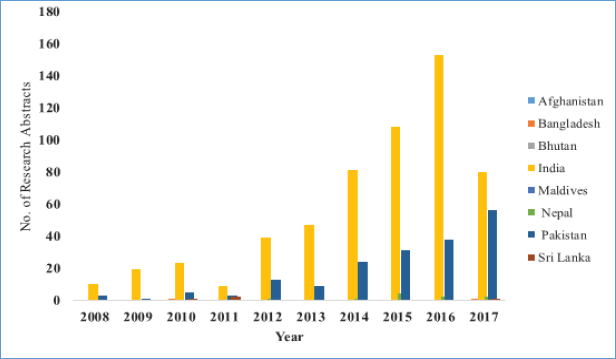 | Figure 1. Status of the decadal output of research papers presentation by SAARC countries at ISPOR meetings (2008–2017). [Click here to view] |
RESULTS AND DISCUSSION
Table 1 shows total number of abstracts published and presented by SAARC countries at ISPOR International Meetings. The trend of publishing the research paper presentations has been on a progressive path from the year 2008 to 2017. The trend is shown in Figure 1. A significant growth of research abstract presentations has been observed in the year between 2014 and 2017. The total number of research abstract presentations available in the scientific database from January 2008 till the end of December 2017 was 768. Among SAARC countries, India had a maximum number of research abstracts presentation (569), followed by Pakistan (183), Nepal (10), Sri Lanka (04), and Bangladesh (02). The highest number of papers published was during the year 2016, with a total of 193 abstracts.
Table 2 indicates total number of research abstracts published and presented by SAARC countries along with foreign/international authors. It is encouraging to note that the number of collaborative research papers with foreign/international authors has been increasing over the last 5 years. The increasing trend is illustrated in Figure 2. There were total 295 publications during the study period (2008–2017). The highest number of papers published was during the year 2017, with a total of 77 abstracts. Among SAARC countries, India had maximum number of research abstracts presentation (191), followed by Pakistan (96), Bangladesh (03), Afghanistan (02), Nepal (02), and Sri Lanka (02).
 | Table 2. Status of collaborative research papers with foreign authors presented by SAARC countries at ISPOR meetings (2008–2017). [Click here to view] |
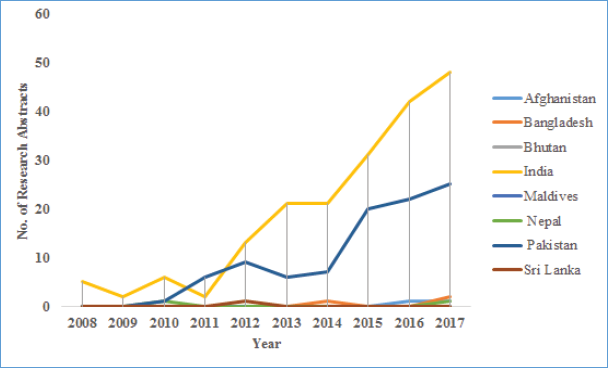 | Figure 2. Status of collaborative research papers with foreign authors presented by SAARC countries at ISPOR meetings (2008–2017). [Click here to view] |
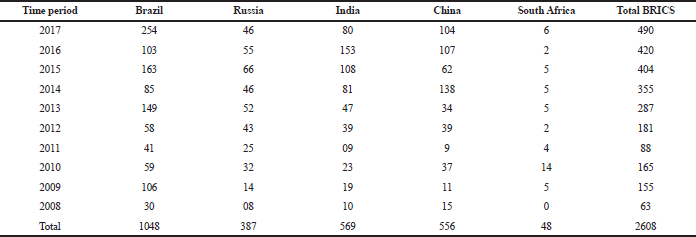 | Table 3. Status of the decadal output of research papers presentation by BRICS countries at ISPOR meetings (2008–2017). [Click here to view] |
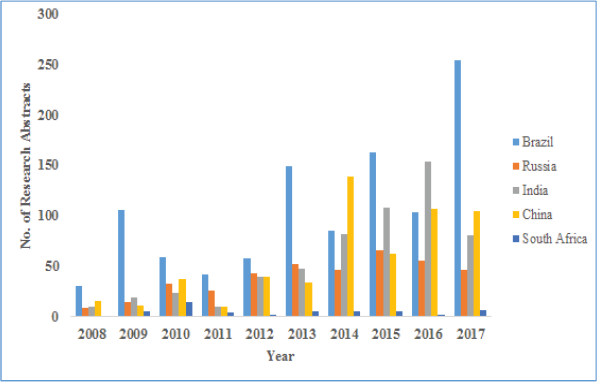 | Figure 3. Status of the decadal output of research papers presentation by BRICS countries at ISPOR meetings (2008–2017). [Click here to view] |
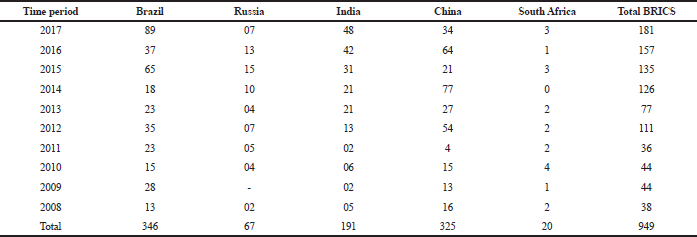 | Table 4. Status of collaborative research papers with foreign authors presented by BRICS countries at ISPOR meetings (2008–2017). [Click here to view] |
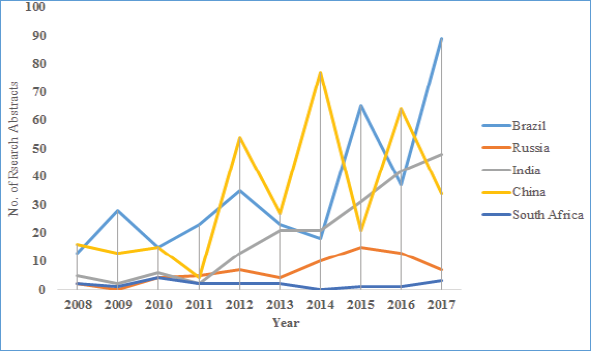 | Figure 4. Status of collaborative research papers with foreign authors presented by BRICS countries at ISPOR meetings (2008–2017). [Click here to view] |
Table 3 shows total number of abstracts published and presented by BRICS countries at ISPOR International Meetings. The trend of publishing the research abstracts has been on a progressive path from the year 2008 to 2017. A significant growth of research abstract presentations has been observed in the year between 2014 and 2017. The total number of research abstract presentations available in the scientific database from January 2008 till the end of December 2017 was 2,608. The trend of publishing research abstract is shown in Figure 3. Among BRICS countries, Brazil had maximum number of research abstracts presentation (1,048), followed by India (569), China (556), Russia (387), and South Africa (48). The highest number of papers published was during the year 2017, with a total of 490 abstracts.
Table 4 indicates total number of research abstracts published and presented by BRICS countries along with foreign/international authors. It is encouraging to note that the number of collaborative research papers with foreign/international authors has been increasing over the last 5 years. There were total of 949 publications during the study period (2008–2017). The highest number of papers published was during the year 2017, with a total of 181 abstracts. Among BRICS countries, Brazil had maximum number of research abstracts presentation (346), followed by China (325), India (191), Russia (67), and South Africa (20). The trend is elucidated in Figure 4.
The presented research abstracts were in promising areas of cost studies, clinical outcome studies, healthcare use and policy studies, research methods, patient-reported outcome, and patient preference studies.
CONCLUSION
Overall, the research output in the above said area from SAARC region is very low compared to the population share in the world, which highlights the need for more awareness in the area of pharmaeconomics and health outcomes research education, research and development, as well as more collaboration in the region as well as in the world. Research in the area of pharmacoeconomics and health outcomes studies has increased in BRICS countries over the last 10 years. The scientific research presentations are on the progressive path by BRICS countries. The collaborative research with foreign authors is also increasing, which is an encouraging trend in this area. Comparatively, India has a good number of scientific research presentations, followed by Pakistan in among SAARC countries. Brazil has a maximum number of scientific research presentations, followed by India and China among BRICS countries. As far as India is concerned, there is a need to learn from the successful developed countries like the USA and European countries, which have highly established pharmacoeconomics guidelines. Currently, India has a shortage of skilled technical workforce, establishing standard guidelines, and insufficient funding for the said research, which are some of the hurdles in the way of this progressive path (Lyles, 2008). Looking at the overall progress of BRICS and SAARC countries in publishing science papers, scientific research presentations in the area of pharmacoeconomics and health outcomes studies are also on a progressive path, nevertheless, still a lot to achieve in the said area. The research carried out by BRICS and SAARC countries in the area of pharmacoeconomics and health outcomes area should be strengthened further which may be beneficial to the society in the coming years.
CONFLICT OF INTEREST
There are no conflicts of interest.
REFERENCES
Ahmad A, Patel I, Parimilakrishnan S, Mohanta GP, Chung HC, Chang J. The role of Pharmacoeconomics in current Indian healthcare system. J Res Pharm Prac, 2013; 2:3–9. CrossRef
Ahmad A, Ashraf, Abbas Z. Current status of research and development in the SAARC region. Sci Technol Dev, 2016; 35:63–66. CrossRef
BRICS. 2018. Available via https://en.wikipedia.org/wiki/BRICS (Accessed 14 June 2018).
BRICS to strengthen cooperation on science and innovation. 2018. Available via http://chinaplus.cri.cn/news/politics/11/20170718/10029.html (Accessed 14 June 2018).
Hasan SA, Luthra R. Comparative performance of India with other BRICS countries in publishing science and engineering research papers. Curr Sci, 2014; 106:1654–7.
Kockaya G, Yenilmez FB, Tuna E. Trend of pharmacoeconomics and health outcome studies in Turkey. 2016 [Online]. Available via https://tools.ispor.org/ScientificPresentationsDatabase/Presentation/70099?pdfid=48577 (Accessed 6 November 2016). CrossRef
Lyles A. Recent trends in pharmacoeconomics: needs and unmet needs. Eur J Pharm Sci, 2008; 34:7–24. CrossRef
Muragundi PM. Pharmacoeconomics—fourth dimension for drug evaluation in India. Curr Sci, 2014; 106:1051.
The role of BRICS in the developing world. 2012. Available via https://www.ecologic.eu/sites/files/project/2013/knoblauch_12_lot5_24_brics.pdf (Accessed on 16 June 2018).